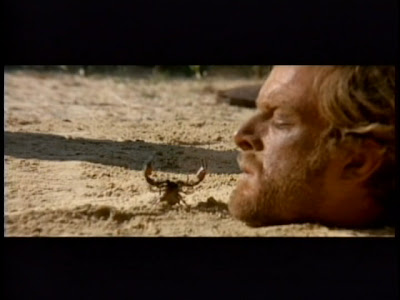One can tell within the first few minutes of 10.000 dollari per un massacro (10,000 Dollars for a Massacre) (1967) that it has the potential to be a doozy of a Western. Django (Gianni Garko, billed here as "Gary Hudson") lays on the beach at sunset, laughing and celebrating with a corpse. The corpse is a lucrative bounty, and Django is tickled pink to cash it in. Crossing the valley, Django spies Manuel Vásquez (Claudio Camaso) on horseback, and the two pass each other by quietly and without incident. It's a fateful meeting, and the two meet several times during the duration of the film. However, only one of the two gunslingers is going to survive this picture.
In an introduction to Westerns All'Italiana: The Wild the Sadist and the Outsiders, Gianni Garko writes:
"In 10.000 Dollari per un massacro and Per 100.000 Dollari T'Ammazzo, I used the assumed name of Gary Hudson,. I impersonated two romantic revenge-driven bounty killers with all the frailties of the common man. In both movies Claudio Camaso, the younger brother of Gian Maria Volonté, portrayed my opponent. I still remember him fondly." (1)
I love Garko's description of his character. The title of the film is ironic. It is clear from the outset of 10.000 dollari per un massacro that above all Django loves money. When Django goes to the sheriff to cash in his latest bounty, the sheriff remarks that Manuel Vásquez's bounty is currently at three thousand. Django scoffs, because he knows that the bounty will get higher. Later that evening at a saloon, Django enters and finds Manuel at a card table. They play an uneasy hand, and Django remarks that the fellow who beat the two at poker cheated. Manuel knifes him in the back and gets his earnings from the corpse's pocket. He splits the take with Django. Pretty saloon owner, Myanou (Loredana Nusciak), chides Django for his violent actions and notes that Django and Manuel are just alike: there is little evidence that she is wrong.
Manuel kidnaps a wealthy landowner's daughter, and the father later goes to see Django who offers him five thousand to retrieve his daughter and kill Manuel. Django scoffs at the offer, again. Django gets critically injured by two of Manuel's gang, and it is pretty Myanou who nurses him back to health. Django has a change of heart and professes his love to the woman. She returns his love and asks him to accompany her to San Francisco, away from the violent life on the frontier. He agrees. The father of the kidnapped daughter appears again and this time offers Django ten-thousand to find his daughter and kill Manuel. Django accepts.
Much of the script of 10.000 dollari per un massacro, penned by Franco Fogagnolo, Ernesto Gastaldi, and Luciano Martino, focuses on the theme that Django, killing criminals for the law for money, and Manuel, a criminal killing anyone for anything, are the same. Wisely, director Romolo Guerrieri focuses his drama on this theme. Guerrieri, incidentally, also helmed two excellent films scripted by Fernando di Leo, the Western, Johnny Yuma (1966), starring Mark Damon and Rosalba Neri, and the crime drama,
Liberi armati pericolosi (1976), starring Eleonora Giorgi and Tomas Milian. At a pivotal point in the film, Django and Manuel agree to commit a stagecoach robbery. Django stipulates that no one is to be harmed. Manuel agrees but reneges on the deal by killing everyone. Why should Django care, if the score from the robbery is the same? The romanticism of Django, which Garko adeptly observes, dies at that moment. It is time for revenge.
There are quite a few attempts at humor in 10.000 dollari per un massacro but most of them fail to inspire laughs and inadvertently, perhaps, make the film a lot more disturbing. I’ve never quite admired Gianni Garko’s acting range, but here, he is quite good. There is a boyish charm to his character which creates a sense of innocence about him, despite the fact that he is a confident gunfighter. When his reality comes crashing down upon him, Garko follows suit and becomes the cold, stoic fighter to whom I am most accustomed. Good-looking Claudio Camaso looks quite a bit like his brother and plays his character of Manuel much as his brother does in the Leone Westerns: very much charismatic yet wholly impulsive and cruel. The action sequences are excellent, and save some plodding scenes, the pacing and tone is well-done.
While 10.000 dollari per un massacro is very much traditional and not quite innovative, it is traditional cinema done exceptionally. I also believe, but am uncertain, that this film is one of the first films to capitalize on the Django character from Sergio Corbucci’s landmark film. Gianni Garko would later cement his own legacy in the Euro-Western as Sartana in multiple films. 10.000 dollari per un massacro is well-worth seeing for fans of the genre.
1. Garko, Gianni, “Introduction.“ Authors, Bruschini, Antonio and Federico de Zigno. Western All’Italiana: The Wild the Sadist and the Outsiders. Glittering Images. Firenze, Italy. 2001: p. 15.




No comments:
Post a Comment